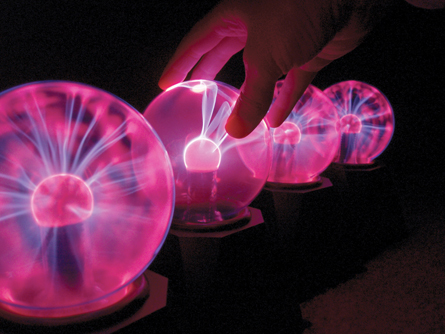Module 3
1. Module 3
1.28. Page 6
Module 3—Electrical Phenomena
 Reflect and Connect
Reflect and Connect

© Katrina Outland/shutterstock
As was mentioned earlier in the lesson, the blue streamers emitted by a plasma lamp have many things in common with St. Elmo’s fire. One key difference is that, within a plasma lamp, the strong electric fields are produced artificially within the glass by the circuitry at the base of the lamp. In the case of St. Elmo’s fire, the strong electric fields are produced naturally at the edges or at the pointed tips of conductors near large concentrations of charge in a thundercloud.
 Discuss
Discuss
D 1. Use the information presented in this lesson to explain why St. Elmo’s fire is observed at the ends of sharply pointed exterior surfaces of aircraft such as wing tips and propellers. Be sure to explain why St. Elmo’s fire is not observed on surfaces that are flat or on interior parts of the aircraft.
D 2. Post your summary to the discussion area set up by your teacher. Compare your summary to at least one other explanation produced by another student. Identify similarities and differences between your work and the work of other students.
D 3. If you were to update your explanation of St. Elmo’s fire, what changes would you make?
 Module 3: Lesson 4 Assignment
Module 3: Lesson 4 Assignment
Remember to submit the answer to D 4 to your teacher as part of your Module 3: Lesson 4 Assignment.
D 4. Use your answers to D 1, D 2, and D 3 to revise your explanation of why St. Elmo’s fire occurs on sharply pointed projections of aircraft and not on flat exterior surfaces or interior surfaces.
Discussion Scoring Guide
Principles involved: electric fields, electrostatic forces, conservation of charge |
||||
Criteria |
Level 1 |
Level 2 |
Level 3 |
Level 4 |
Knowledge |
||||
Demonstrates a vague and sometimes incorrect understanding of the physics principles involved. Obvious irrelevant or missing information. |
Demonstrates a basic understanding of the physics principles involved. May exhibit minor mistakes or vague information or application to the situation. |
Demonstrates a good understanding of the physics principles involved and applies them properly to the given situation. All necessary information is given. |
Demonstrates a superior understanding of the physics principles involved and their application to the situation. All applications are considered in detail. |
|
Reflection |
||||
The post shows reflection on one’s own and other students’ work. Contributes to the group discussion. |
Does not make an effort to participate. Seems indifferent to discussion. |
Occasionally makes meaningful reflections on the group’s efforts or discussions. Marginal effort is shown to become involved with the group or discussion. |
Frequently makes meaningful reflections on the group’s efforts and presents relevant viewpoints for consideration by the group. Interacts freely with group members. |
Regularly attempts to motivate the group discussion and delve deeper into concepts. Interacts freely and encourages all group members. |
Content and presentation of discussion summary |
||||
The information is logically arranged in a clear and concise manner. |
The information is poorly organized with many concepts implied. Irrelevant or rambling sentences make reading difficult. |
The information is somewhat organized with implied concepts. Excessive words or awkward sentences are used, which hinder reading. |
The information is well-organized and logically arranged. All concepts are explicitly explained. There are a few awkward but understandable sentences. |
The information is well- organized and very easy to understand. Well-worded sentences make reading pleasurable. |
 Module 3: Lesson 4 Assignment
Module 3: Lesson 4 Assignment
Remember to submit the Module 3: Lesson 4 Assignment to your teacher for marks.